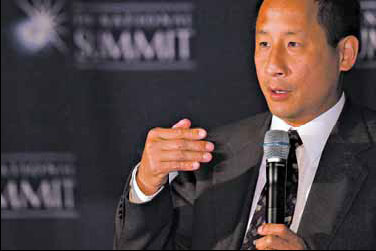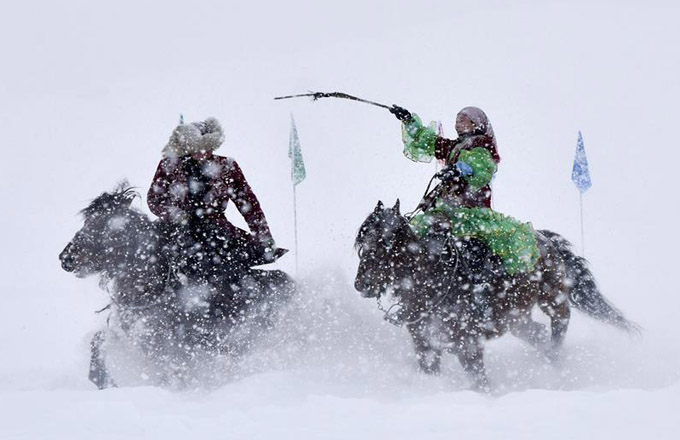

For decades, scientists have been on the lookout for killer objects from outer space that could devastate the planet. But warnings that they lacked the tools to detect the most serious threats were largely ignored.
 |
|
Edward Lu, a Google executive who was a NASA astronaut, is part of an effort to launch a private space telescope to spot asteroids. Jim Watson / Agence France-Presse - Getty Images |
No more. The meteor that rattled Siberia on February 15, injuring hundreds of people and traumatizing thousands, has suddenly brought new life to efforts to deploy adequate detection tools, in particular a space telescope that would scan the solar system for dangers.
A group of young Silicon Valley entrepreneurs who helped build thriving companies like eBay, Google and Facebook has already put millions of dollars into the effort and saw the Russian shock wave as a turning point in raising hundreds of millions more.
"Wouldn't it be silly if we got wiped out because we weren't looking?" said Edward Lu, a former NASA astronaut and Google executive who leads the detection effort. "This is a wake-up call from space. We've got to pay attention to what's out there."
Astronomers know of no asteroids or comets that pose a major threat to the planet. But NASA estimates that fewer than 10 percent of the big dangers have been discovered.
Dr. Lu's group, based in Mountain View, California, and called the B612 Foundation after the Little Prince's imaginary asteroid, is one team of several pursuing ways to ward off extraterrestrial threats. The National Aeronautics and Space Administration is another, and other private groups are emerging, like Planetary Resources, which wants not only to identify asteroids near Earth but also to mine them.
"Our job is to be the first line of defense, and we take that very seriously," James Green, the director of planetary science at NASA headquarters, said after the Russian strike.The slow awakening to the danger began long ago, as scientists found hundreds of rocky scars indicating that cosmic intruders had reshaped the planet.
The discoveries included not just obvious features like Meteor Crater in Arizona, but wide zones of upheaval. A crater more than 160 kilometers wide beneath the Yucatan Peninsula in Mexico suggested that, 65 million years ago, a speeding rock from outer space had raised enough planetary mayhem to end the reign of the dinosaurs.
Starting in the 1980s and 1990s, astronomers turned their telescopes on the sky with increasing vigor to look for killer rocks. The rationale was statistical. They knew about a number of near misses and calculated that many other rocky threats whirling about the solar system had gone undetected.
In 1996, the Air Force also began scanning the skies for speeding rocks, giving credibility to an activity once seen as reserved for doomsday enthusiasts. It was the first known government search.
NASA took a lead role with what it called the Spaceguard Survey. In 2007, it issued a report estimating that 20,000 asteroids and comets orbited close enough to the planet to deliver blows that could destroy cities or even end all life. Today, NASA supports modest telescopes in the southwestern United States and in Hawaii that make more than 95 percent of the discoveries of the objects coming near the Earth.
Scientists lobbied hard for a space telescope that would get high above the distorting effects of the Earth's atmosphere. It would orbit the Sun and would have a much better chance of finding large space rocks.
But financing never materialized. Last year, Dr. Lu, who left the NASA astronaut corps in 2007 to work for Google, joined with veterans of the space program and Silicon Valley entrepreneurs to accelerate the asteroid hunt.
The B612 Foundation refers to its planned telescope as the world's first private mission to deep space.
The plan is to launch a large telescope known as Sentinel that can find 90 percent of the asteroids larger than 140 meters in diameter that pass through the Earth's part of the solar system. The foundation also wants to discover asteroids down to a diameter of 30 meters.
Such asteroids are much bigger than the meteor that hit the atmosphere over Russia.
Dr. Lu said the overall cost of the mission was now estimated at $450 million. The group, far from that goal, has been soliciting money from citizens.
James Green, director of planetary science at NASA, said it was preparing to launch a mission in 2016 that will fly to an asteroid and, in 2023, return a sample to Earth for detailed analyses.
"If you're going to protect the planet, you have to know your enemy," he said. "You have to get up close and personal."
The New York Times







